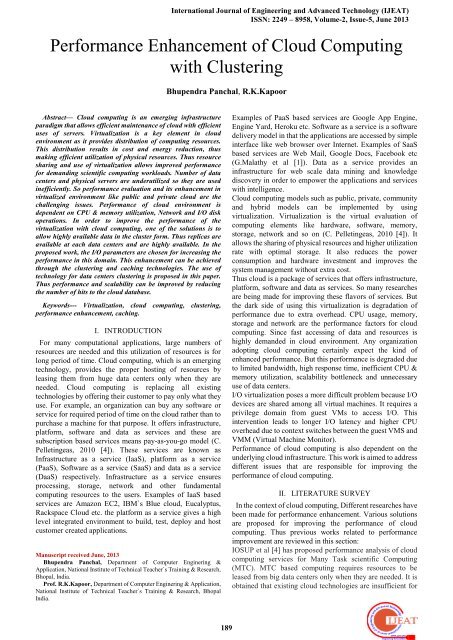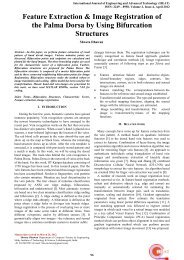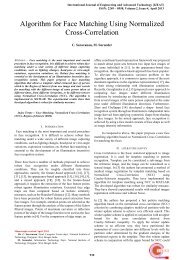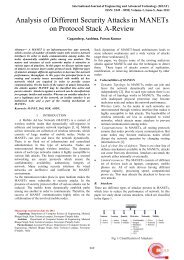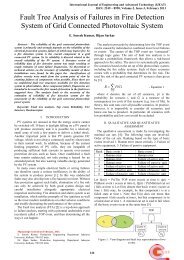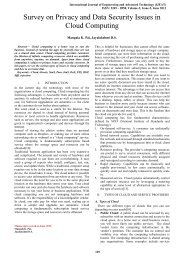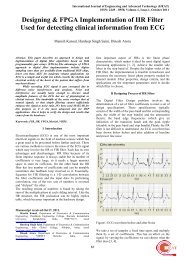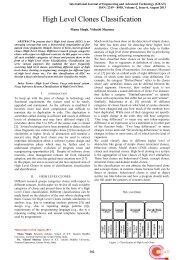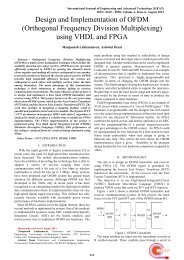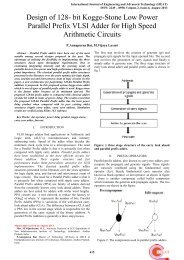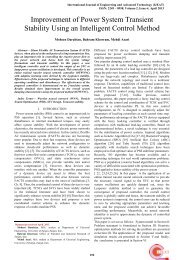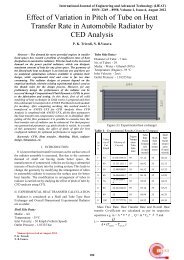Performance Enhancement of Cloud Computing with Clustering
Performance Enhancement of Cloud Computing with Clustering
Performance Enhancement of Cloud Computing with Clustering
You also want an ePaper? Increase the reach of your titles
YUMPU automatically turns print PDFs into web optimized ePapers that Google loves.
International Journal <strong>of</strong> Engineering and Advanced Technology (IJEAT)ISSN: 2249 – 8958, Volume-2, Issue-5, June 2013<strong>Performance</strong> <strong>Enhancement</strong> <strong>of</strong> <strong>Cloud</strong> <strong>Computing</strong><strong>with</strong> <strong>Clustering</strong>Bhupendra Panchal, R.K.KapoorAbstract— <strong>Cloud</strong> computing is an emerging infrastructureparadigm that allows efficient maintenance <strong>of</strong> cloud <strong>with</strong> efficientuses <strong>of</strong> servers. Virtualization is a key element in cloudenvironment as it provides distribution <strong>of</strong> computing resources.This distribution results in cost and energy reduction, thusmaking efficient utilization <strong>of</strong> physical resources. Thus resourcesharing and use <strong>of</strong> virtualization allows improved performancefor demanding scientific computing workloads. Number <strong>of</strong> datacenters and physical servers are underutilized so they are usedinefficiently. So performance evaluation and its enhancement invirtualized environment like public and private cloud are thechallenging issues. <strong>Performance</strong> <strong>of</strong> cloud environment isdependent on CPU & memory utilization, Network and I/O diskoperations. In order to improve the performance <strong>of</strong> thevirtualization <strong>with</strong> cloud computing, one <strong>of</strong> the solutions is toallow highly available data in the cluster form. Thus replicas areavailable at each data centers and are highly available. In theproposed work, the I/O parameters are chosen for increasing theperformance in this domain. This enhancement can be achievedthrough the clustering and caching technologies. The use <strong>of</strong>technology for data centers clustering is proposed in this paper.Thus performance and scalability can be improved by reducingthe number <strong>of</strong> hits to the cloud database.Keywords--- Virtualization, cloud computing, clustering,performance enhancement, caching.I. INTRODUCTIONFor many computational applications, large numbers <strong>of</strong>resources are needed and this utilization <strong>of</strong> resources is forlong period <strong>of</strong> time. <strong>Cloud</strong> computing, which is an emergingtechnology, provides the proper hosting <strong>of</strong> resources byleasing them from huge data centers only when they areneeded. <strong>Cloud</strong> computing is replacing all existingtechnologies by <strong>of</strong>fering their customer to pay only what theyuse. For example, an organization can buy any s<strong>of</strong>tware orservice for required period <strong>of</strong> time on the cloud rather than topurchase a machine for that purpose. It <strong>of</strong>fers infrastructure,platform, s<strong>of</strong>tware and data as services and these aresubscription based services means pay-as-you-go model (C.Pelletingeas, 2010 [4]). These services are known asInfrastructure as a service (IaaS), platform as a service(PaaS), S<strong>of</strong>tware as a service (SaaS) and data as a service(DaaS) respectively. Infrastructure as a service ensuresprocessing, storage, network and other fundamentalcomputing resources to the users. Examples <strong>of</strong> IaaS basedservices are Amazon EC2, IBM`s Blue cloud, Eucalyptus,Rackspace <strong>Cloud</strong> etc. the platform as a service gives a highlevel integrated environment to build, test, deploy and hostcustomer created applications.Manuscript received June, 2013Bhupendra Panchal, Department <strong>of</strong> Computer Enginering &Application, National Institute <strong>of</strong> Technical Teacher`s Training & Research,Bhopal, India.Pr<strong>of</strong>. R.K.Kapoor, Department <strong>of</strong> Computer Enginering & Application,National Institute <strong>of</strong> Technical Teacher`s Training & Research, BhopalIndia.Examples <strong>of</strong> PaaS based services are Google App Engine,Engine Yard, Heroku etc. S<strong>of</strong>tware as a service is a s<strong>of</strong>twaredelivery model in that the applications are accessed by simpleinterface like web browser over Internet. Examples <strong>of</strong> SaaSbased services are Web Mail, Google Docs, Facebook etc(G.Malathy et al [1]). Data as a service provides aninfrastructure for web scale data mining and knowledgediscovery in order to empower the applications and services<strong>with</strong> intelligence.<strong>Cloud</strong> computing models such as public, private, communityand hybrid models can be implemented by usingvirtualization. Virtualization is the virtual evaluation <strong>of</strong>computing elements like hardware, s<strong>of</strong>tware, memory,storage, network and so on (C. Pelletingeas, 2010 [4]). Itallows the sharing <strong>of</strong> physical resources and higher utilizationrate <strong>with</strong> optimal storage. It also reduces the powerconsumption and hardware investment and improves thesystem management <strong>with</strong>out extra cost.Thus cloud is a package <strong>of</strong> services that <strong>of</strong>fers infrastructure,platform, s<strong>of</strong>tware and data as services. So many researchesare being made for improving these flavors <strong>of</strong> services. Butthe dark side <strong>of</strong> using this virtualization is degradation <strong>of</strong>performance due to extra overhead. CPU usage, memory,storage and network are the performance factors for cloudcomputing. Since fast accessing <strong>of</strong> data and resources ishighly demanded in cloud environment. Any organizationadopting cloud computing certainly expect the kind <strong>of</strong>enhanced performance. But this performance is degraded dueto limited bandwidth, high response time, inefficient CPU &memory utilization, scalability bottleneck and unnecessaryuse <strong>of</strong> data centers.I/O virtualization poses a more difficult problem because I/Odevices are shared among all virtual machines. It requires aprivilege domain from guest VMs to access I/O. Thisintervention leads to longer I/O latency and higher CPUoverhead due to context switches between the guest VMS andVMM (Virtual Machine Monitor).<strong>Performance</strong> <strong>of</strong> cloud computing is also dependent on theunderlying cloud infrastructure. This work is aimed to addressdifferent issues that are responsible for improving theperformance <strong>of</strong> cloud computing.II. LITERATURE SURVEYIn the context <strong>of</strong> cloud computing, Different researches havebeen made for performance enhancement. Various solutionsare proposed for improving the performance <strong>of</strong> cloudcomputing. Thus previous works related to performanceimprovement are reviewed in this section:IOSUP et al [4] has proposed performance analysis <strong>of</strong> cloudcomputing services for Many Task scientific <strong>Computing</strong>(MTC). MTC based computing requires resources to beleased from big data centers only when they are needed. It isobtained that existing cloud technologies are insufficient for189
<strong>Performance</strong> <strong>Enhancement</strong> <strong>of</strong> <strong>Cloud</strong> <strong>Computing</strong> <strong>with</strong> <strong>Clustering</strong>scientific computing but they may be still good solution forthose that required resources instantly and temporarily.Donglai Zhang et al [2] proposed WSDF framework forimproved data transfer performance <strong>of</strong> web serviceworkflows. This framework allows directly data sharingbetween consecutive web services <strong>with</strong>in a web serviceworkflow. Thus it allows improved performance and betterdata transfer speed between different components <strong>of</strong> aworkflow.Wei Huang et al [3] proposed a framework for performanceand management overheads <strong>with</strong> virtual machines. Two casesare considered: one is Virtual Machine Monitor (VMM)bypass I/O and another is VM image management. VMMbypass I/O extends the OS bypass feature <strong>of</strong> modern highspeed interconnects such as InfiniBand and VM imagemanagement is done <strong>with</strong> three aspects: Customizing smallkernels, developing fast and scalable distribution schemes forlarge scale clusters and VM image caching on computingnodes. Both these cases are having significant performance<strong>with</strong> VMs.Joyent et al [8] has introduced Smart technologies for cloudperformance. These Smart technologies <strong>of</strong>fer enhancedperformance <strong>with</strong> scalability, light weight virtualization,flexible resource provisioning, dynamic load balancing,storage caching and CPU bursting. Scalability <strong>of</strong> cloudenvironment can be improved from its SmartOS operatingsystem, SmartMachine virtualization technology,SmartDataCenter infrastructure management system to itssmartPlatform development environment. According toJoyent, scalability is the best solution to increase theperformance <strong>of</strong> cloud computing environment.III. PROBLEM PERCEIVED IN THIS AREAIt is difficult to match a good definition <strong>of</strong> cloud computingdue to lack <strong>of</strong> standardization and economical impact.Standardizations <strong>of</strong> reliability and security are main concernnow- a- days. Because these issues are facing daily newchallenges. As cloud computing is an on demand service thatshares a pool <strong>of</strong> resources over the network. Thus cloudsecurity and reliability to its users are the major issues to beresearched in this area and both <strong>of</strong> them make it hard tounderstand.In other hand, economical impact <strong>of</strong> cloud allows thatresources could be used in more efficient and intelligent waysby reducing the cost. This can be achieved by virtualizationbecause it requires less storage space <strong>of</strong> the servers and alsoreduction <strong>of</strong> power consumption.Latency and interoperability are also major issues to be solvedin cloud computing because their causes are engineered intothe cloud platforms themselves.One <strong>of</strong> the most important issues in cloud computing is theperformance overhead. Since fast accessing <strong>of</strong> data andresources is highly demanded in cloud environment. Anyorganization adopting cloud computing certainly expect thekind <strong>of</strong> enhanced performance. But this performance isdegraded due to limited bandwidth, high response time,inefficient CPU & memory utilization, scalability bottleneckand unnecessary use <strong>of</strong> data centers.I/O virtualization poses a more difficult problem because I/Odevices are shared among all virtual. It requires a privilegedomain from guest VMs to access I/O. This intervention leadsto longer I/O latency and higher CPU overhead due to contextswitches between the guest VMS and VMM (Virtual MachineMonitor). <strong>Performance</strong> <strong>of</strong> cloud computing is also dependenton the underlying cloud infrastructure.IV. PROPOSED METHODOLOGY<strong>Performance</strong> is the major concern in the field <strong>of</strong> cloudcomputing. People are running into the scalability. Butincreasing number <strong>of</strong> Virtual machine and CPU is not the keysolution for scalability, because cost is another issue to beresearched then. So the area which is identified for improvingthe performance is to avoid the unnecessary use <strong>of</strong> databases.Data centers are highly loaded for accessing I/O requests.Although operations on huge amount <strong>of</strong> data in cloudcomputing are quite complex and lead to be performanceoverheads. There may be a case <strong>of</strong> server failure. So from thedevelopment, maintenance and performance perspective, allthese can be serious issues to be refined. One <strong>of</strong> the solutionsis to allow highly available data in the cluster form. Thusreplicas are available at each data centers and are highlyavailable. In our work, the I/O parameters are chosen forincreasing the performance in this domain. This enhancementcan be achieved through the clustering and cachingtechnologies.Cluster based data centers are highly efficient for performingI/O operations. Clusters can be defined as collection <strong>of</strong> virtualdata servers and are treated as a single machine. <strong>Clustering</strong>avoids uninterrupted access to data and also helps whennetwork or storage connectivity is lost. Caching, in otherhand, prevents over hits to the databases. Network cachingand VM image caching are the two aspects that are proposedfor this purpose. Thus the idea behind both these technologiesis to minimize the information that move among the differentcloud components. Although clustering can be done atdifferent level such as OS level, Application level, web serverlevel and database level.<strong>Clustering</strong> among the data centers that are located throughoutthe world, allow highly available data for customers <strong>with</strong>outany delay. Thus if one data center is goes down, everything inthe second data center is clustered <strong>with</strong> the first, so there is noproblem for the time being. And you still havedatabase/web/app server in the second data center.In the favour <strong>of</strong> our work several issues are identified forbetter performance <strong>of</strong> cloud services. In some previousstudies it is established that clustering can be a keycontributing factor to improve the performance in cloudcomputing.G.Malathy et al [1] proposed the Reservation Clusterapproach for performance enhancement in cloud computing.The concept <strong>of</strong> reservation cluster is to schedule the tasks.Unscheduled tasks are sent to the reservation cluster and inthis cluster all the tasks are scheduled simultaneously <strong>with</strong>outany iteration. It reduces the amount <strong>of</strong> computation time andresource usage and allows better performance.A.Mahendiran et al [10] proposed the implementation <strong>of</strong>K-Means clustering algorithm in cloud computing for largedata sets. The work was focused to implement and deployK-Means algorithm in Google <strong>Cloud</strong> using Google AppEngine <strong>with</strong> cloud SQL. Thus cloud computing allows mining<strong>of</strong> large databases and storing them <strong>with</strong> less cost. Resultsshow that clustering works well in the cloud.Since cloud is having the large data sets and these data sets areregularly accessed as per user requirements. Michael Shindleret al [11] have proposed fast and accurate k means algorithmas a solution where the data is too large and must be accessed190
International Journal <strong>of</strong> Engineering and Advanced Technology (IJEAT)ISSN: 2249 – 8958, Volume-2, Issue-5, June 2013sequentially. BigCross dataset and census 1990 dataset wereconsidered as large data sets for applying the proposedclustering algorithm. Experiments show the significant resultsin terms <strong>of</strong> cost and response time.P. Ashok et al [12] has proposed renovated k-meansalgorithm for Iris and Wine datasets. Proposed algorithm iscompared <strong>with</strong> K-means, static weighted K-means andDynamic weighted K-means on three different distancefunction. Less execution time and minimum iteration count <strong>of</strong>proposed k- means help to improve the performance.Karedla, R. Et al[13] has proposed the caching strategies toincrease the system response time and data throughput <strong>of</strong> thedisk. Results show that caching <strong>of</strong>fers the twice performance<strong>of</strong> its size.Q. Luo et al [14] has proposed the Active Query Caching forimproving scalability <strong>of</strong> database web servers. It allows theload sharing <strong>of</strong> database in order to reduce the network traffic.This caching is applied at query level for simplifying querycontainment checking and query evaluation at the proxy. Thisquery level caching allows fast response to the user queriesand hence improve the web server performance.Proposed architecture stack using clustering is shown infigure:Fig1: Architecture for cloud computing using<strong>Clustering</strong>Proposed clustering and caching technologies are integratedat the physical level where the data servers are located. Thusclusters <strong>of</strong> data centers are formed at this level. And abstractlevel (i.e. virtualization layer) is responsible for load sharingamong the datacenters. In order to scale the performance <strong>of</strong>data centers, a pool <strong>of</strong> data centers tied together to act as asingle unit called cluster. These clustering technologies aretransparent to client applications. <strong>Clustering</strong> and cachingtechniques can be seemed a better solutions for fast accessing<strong>of</strong> data and I/O operations. In this way, proposed methods forreducing data traffic and also minimizing the database hits canhave better performance than cloud environments that are notusing clustering <strong>of</strong> data centres.V. CONCLUSION<strong>Performance</strong> <strong>of</strong> virtualization <strong>with</strong> cloud computing is amajor issue to be researched. Poor performance can lack theinterest <strong>of</strong> customers. <strong>Clustering</strong> and caching are the proposedmethodologies for improving the performance in this work.Both these technologies have their own significant.<strong>Clustering</strong> <strong>of</strong> data centers, network caching and VM imagecaching are the key points that are used as performanceparameters. Expected results can have better performancethan existing one.ACKNOWLEDGMENTI would like to express my special thanks <strong>of</strong> gratitude to myguide Dr. R.K.Kapoor for his support, his supervision and histime. He provides me better opportunity to understand theconcepts <strong>of</strong> cloud computing. His valuable guidance allowedme to understand and work in the area <strong>of</strong> cloud computing.REFERENCES[1] G. Malathy, Rm. Somasundaram, “<strong>Performance</strong> <strong>Enhancement</strong> in<strong>Cloud</strong> <strong>Computing</strong> using Reservation Cluster”, European Journal <strong>of</strong>Scientific Research, ISSN 1450-216X Vol. 86 No 3 September, 2012,pp.394-401[2] Donglai Zhang, Paul Coddington and Andrew Wendelborn,”Improving Data Transfer <strong>Performance</strong> <strong>of</strong> Web Service Workflows inthe <strong>Cloud</strong> Environment”, Int. J. Computational Science andEngineering, Vol. 1, No. 1/1, 2012[3] Wei Huang , Jiuxing Liu, Bulent Abali and Dhabaleswar K. Panda,“A Case for High <strong>Performance</strong> <strong>Computing</strong> <strong>with</strong> Virtual Machines”,ICS ’06 Proceedings <strong>of</strong> the 20 th annual international conference onsupercomputing, pages 125-134[4] C. Pelletingeas, “<strong>Performance</strong> Evaluation <strong>of</strong> Virtualization <strong>with</strong><strong>Cloud</strong> <strong>Computing</strong>”, MSc Advanced Networking, 2010[5] Alexandru Iosup, Simon Ostermann, M. Nezih Yigitbasi,“<strong>Performance</strong> Analysis <strong>of</strong> <strong>Cloud</strong> <strong>Computing</strong> Services forMany-Tasks Scientific <strong>Computing</strong>”, IEEE Transaction on paralleland distributed system, VOL. 22, NO. 6, JUNE 2011[6] Mattias Sunding, Maximizing Virtual Machine <strong>Performance</strong>, vkernelcorporation, A Quest S<strong>of</strong>tware Company, http://www.vkernel.com[7] Devarshi Ghosal, R.Shane Canon and Lavanya Ramakrishnan,”I/O<strong>Performance</strong> <strong>of</strong> Virtualized <strong>Cloud</strong> Enviornment”[8] Joyent White paper, <strong>Performance</strong> and scale in cloud computing[9] Nikolaus Huber, Marcel von Quast, Micahal Hauck and SamuelKonev, “Evaluating and Modeling Virtualization <strong>Performance</strong>Overhead for <strong>Cloud</strong> Enviornments”[10] A. Mahendiran, N. Saravanan, N. Venkata Subramanian and N.Sairam, “Implementation <strong>of</strong> K-Means <strong>Clustering</strong> in <strong>Cloud</strong><strong>Computing</strong> Environment” , Research Journal <strong>of</strong> Applied Sciences,Engineering and Technology 4(10): 1391-1394, 2012 ISSN:2040-7467[11] Michael Shindler, Alex Wong and , and Adam Meyerson “Fast andAccurate k-means For Large Datasets”[12] P. Ashok, Dr. G.M Kadhar Nawaz, E.Elayaraja and V. Vadivel,“Improved <strong>Performance</strong> <strong>of</strong> Unsupervised Method by RenovatedK-Means”[13] Karedla, R., Love, J.S. and Wherry,B.G.,”Caching strategies toimprove disk system performance”,IEEE computer Society, VOL.27, March 1994[14] Q. Luo, J.F.Naughton, R.Krishnamurthy, Pei Cao and YunruiLi,”Active Query Caching for Database Web Servers”, WebDB 2000,LNCS 1997, pp. 92-104, 2001Bhupendra Panchal received the Bachelor <strong>of</strong>engineering from Mahakal Institute <strong>of</strong> Technology,Ujjain(M.P.) in 2011 and pursuing M.Tech. inComputer Technology & Application from NationalInstitute <strong>of</strong> Technical Teacher`s Training & Research,Bhopal(M.P.)Pr<strong>of</strong>. R. K. Kapoor received B.Sc., M.Sc. and PostGraduation diploma in Computer Science andApplication from Barakatullah University, Bhopal in1985, 1988 and 1990 respectively. He held MBA in1998 from Devi Ahilya Vishvavidyalaya, Indore andalso awarded <strong>with</strong> Ph.D. in 2012 from MANIT, Bhopal. He is working asassociate pr<strong>of</strong>essor in National Institute <strong>of</strong> Technical Teacher`s Training &Research, Bhopal(M.P.)(From 30/12/2010)191


